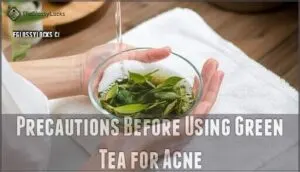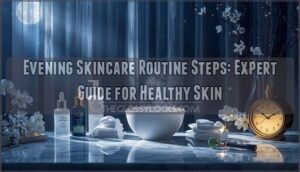This site is supported by our readers. We may earn a commission, at no cost to you, if you purchase through links.
 You can use green tea for acne in several effective ways that won’t break the bank or irritate your skin.
You can use green tea for acne in several effective ways that won’t break the bank or irritate your skin.
Brew a strong cup, let it cool, then apply it as a toner using a cotton pad – this delivers anti-inflammatory compounds directly to problem areas.
Alternatively, mix used tea leaves with honey to create a gentle weekly mask that reduces oil production while fighting bacteria.
Drinking green tea regularly also supports clearer skin from the inside out by reducing inflammation throughout your body.
The polyphenols in green tea basically tell your overactive sebaceous glands to calm down while simultaneously creating an environment where acne-causing bacteria can’t thrive.
But timing and preparation methods can make or break your results.
Table Of Contents
- Key Takeaways
- How Green Tea Works for Acne
- How to Use Green Tea for Acne
- Precautions Before Using Green Tea for Acne
- Can Green Tea Help With Acne Scars?
- Which Tea is Good for Acne Scars?
- What Can I Drink to Clear Acne?
- Frequently Asked Questions (FAQs)
- Does green tea cause acne?
- How to use green tea on face?
- How to get rid of pimples with green tea?
- Is green tea good for acne & oily skin?
- Can you use green tea extract on acne?
- Can I rub green tea on my face?
- How many green tea per day for acne?
- Does washing your face with green tea help acne?
- Does green tea purge skin?
- Can I drink green tea to clear my acne?
- Conclusion
Key Takeaways
- Apply green tea topically for direct results – Brew strong tea, let it cool, then use it as a toner with cotton pads or mix used tea leaves with honey for a weekly mask that reduces oil production and fights acne-causing bacteria.
- Drink 2-3 cups daily to fight acne from within – Green tea’s polyphenols and EGCG compounds work internally to reduce inflammation throughout your body and regulate sebum production in your skin.
- Always prep your skin properly before application – Clean your face thoroughly and remove all makeup before applying green tea treatments to ensure maximum absorption of the anti-inflammatory compounds.
- Stay consistent but don’t overdo it – Use green tea masks 1-2 times weekly and stick to moderate daily consumption to avoid side effects like jitteriness, while allowing time for the 60% reduction in facial oil that studies show within weeks.
How Green Tea Works for Acne
Green tea works against acne by controlling your skin’s oil production and reducing the bacteria that cause breakouts.
The powerful compounds in green tea, especially EGCG, target the root causes of acne by regulating sebum levels and fighting inflammation in your pores.
It Controls Oil Production
Your sebaceous glands constantly pump out sebum, but green tea puts the brakes on this oil production.
The EGCG in green tea directly targets these glands, achieving impressive sebum regulation by interrupting lipid synthesis pathways.
This androgen influence disruption means less greasy skin and fewer clogged pores.
Green tea’s efficacy stems from its anti-inflammatory properties, which help to calm irritated skin.
Studies show a 60% reduction in facial oil within weeks of consistent green tea acne treatment.
It Reduces Acne-Causing Bacteria
Beyond controlling oil, green tea’s antibacterial mechanisms target acne-causing bacteria directly.
These powerful compounds disrupt C. acnes impact on your skin, preventing bacterial colonization in pores. Green tea contains catechins, which have anti-inflammatory effects.
Here’s how green tea synergy works against acne:
- Catechins disrupt bacterial cell membranes – stopping reproduction cycles
- Polyphenols provide broad-spectrum protection – targeting multiple bacterial strains
- Consistent use prevents resistance development – maintaining long-term effectiveness
How to Use Green Tea for Acne
You can apply green tea for acne treatment in two primary ways: as a topical mask or by consuming it regularly as a beverage.
Both methods harness green tea’s anti-inflammatory compounds and antioxidants to reduce sebum production, fight acne-causing bacteria, and minimize skin irritation, utilizing its anti-inflammatory properties.
As a Mask
Creating a green tea mask offers targeted acne treatment through topical application. Mix cooled green tea leaves with water to form a paste-like consistency. Apply this facial mask evenly across clean skin, allowing powerful antioxidants to penetrate pores and combat acne-causing bacteria.
You can explore options for a pre-made acne mask if you prefer not to make your own.
| Mask Component | Benefit |
|---|---|
| Green tea leaves | Reduces inflammation |
| Honey addition | Antibacterial properties |
| Clay mixture | Deep pore cleansing |
| Oatmeal blend | Gentle exfoliation |
| Aloe vera | Soothing hydration |
For Masking Sensitive Skin, start with shorter application times. Mask Application Frequency should be 1-2 times weekly. DIY Mask Recipes can incorporate Mask Ingredient Synergies like tea tree oil. Masking Benefits Timeline shows improvements within 2-4 weeks of consistent use.
Consume It
The most straightforward approach to harness green tea’s acne-fighting power is through oral consumption.
Green tea delivers potent antioxidants called catechins directly into your bloodstream, targeting inflammation from within.
You’ll want to stick to 2-3 cups daily to avoid potential side-effects like jitteriness from excessive caffeine.
Consider these practical options for incorporating green tea into your routine:
- Brewing methods: Steep loose-leaf or high-quality bagged tea for 3-5 minutes in water heated to 175°F
- Tea brands: Choose organic varieties like Sencha or Matcha for maximum EGCG content
- Supplement forms: Green tea extract capsules offer concentrated dosage amounts when beverages aren’t convenient
Remember, supplements require medical consultation, especially if you’re taking medications.
Precautions Before Using Green Tea for Acne
Before you start using green tea for acne treatment, you’ll need to understand some important safety considerations that can affect your results and overall health.
Taking the right precautions guarantees you get the maximum benefits from green tea while avoiding potential side effects or skin irritation.
Always Use It on Clean Skin
Clean slate, better results – that’s the golden rule when applying green tea for acne treatment.
Your skin absorbs green tea’s powerful compounds most effectively when it’s properly prepped and free from barriers like makeup, dirt, or excess oil.
Follow these essential pre-cleansing importance steps for ideal acne skincare results:
- Wash hands thoroughly before touching your face to prevent bacterial transfer
- Use gentle cleansers that won’t strip your skin’s natural moisture barrier
- Remove all makeup and sunscreen completely before applying tea for acne treatments
- Pat skin dry with a clean towel, avoiding harsh rubbing motions
- Wait 2-3 minutes after cleansing before applying green tea skin care products
Post-cleanse hydration matters too.
Clean skin creates the perfect canvas for green tea’s acne-fighting properties to penetrate deeply and work effectively, following the essential pre-cleansing steps for a clean slate and better skincare results.
Don’t Over-Consume It
Multiple cups of green tea daily might seem harmless, but dosage concerns exist when you’re targeting acne treatment.
Excessive caffeine intake can trigger dehydration and disrupt sleep patterns, potentially worsening skin conditions. Green tea supplements pose greater supplement risks than brewed tea, with high concentrations potentially affecting liver health.
The antioxidant benefits don’t increase proportionally with consumption—your body can only process so much. Side effects include jitteriness, headaches, and stomach upset. Medication interactions can occur, especially with blood thinners.
Green tea masks can also provide benefits, such as pore cleansing mechanisms, when used topically. Stick to 2-3 cups daily for ideal green tea acne benefits without overwhelming your system.
Benefits
Recommended Consumption
Precautions
Can Green Tea Help With Acne Scars?
While green tea’s antioxidants and anti-inflammatory compounds can help reduce the appearance of acne scars over time, you shouldn’t expect dramatic results from this natural remedy alone.
The EGCG and polyphenols in green tea support skin healing and collagen production, which may gradually improve scar texture when used consistently as part of your skincare routine, potentially leading to better skin healing.
Treatment Methods
Green tea offers several proven treatment methods for tackling acne scars effectively.
Your approach should combine multiple strategies for maximum results:
- Topical application: Apply green tea mask twice weekly, leaving it on for 15-20 minutes to maximize antioxidant absorption
- Compress duration: Use cooled green tea bags as compresses for 10 minutes to reduce inflammation and promote healing
- Product combinations: Mix green tea extract with healing ingredients like honey or aloe vera for enhanced scar-fighting power
These application techniques target scar tissue systematically.
Consistent use of sunscreen is essential for scar healing.
Precautions and Consistency
Treatment success hinges on proper precautions and consistent use.
Always perform a patch test before full application to avoid allergic reactions and skin irritation. Monitor for side effects during your treatment duration.
Consistent application trumps sporadic use—think marathon, not sprint. Some trial and error helps identify what works for your skin sensitivity and prevents product interactions.
| Precaution | Action Required |
|---|---|
| Patch Test | Apply small amount 24 hours before use |
| Skin Sensitivity | Start with diluted concentrations |
| Product Interactions | Avoid mixing with harsh actives |
| Treatment Duration | Allow 6-8 weeks for visible results |
Which Tea is Good for Acne Scars?
When selecting tea for acne scars, you’ll find that high-quality green tea varieties with elevated EGCG content offer the most effective results.
Chinese and Japanese green teas, particularly those from first harvests, contain higher concentrations of the antioxidants that support skin healing and reduce scar appearance, making them a good choice for acne scars.
Green Tea Varieties
Different green tea varieties from the Camellia sinensis plant offer unique benefits for acne-prone skin. Your choice depends on EGCG content, flavor profiles, and country of origin preferences.
- Sencha: Japan’s most popular green tea delivers robust antioxidant levels with a fresh, grassy taste. This highquality tea provides excellent anti-inflammatory properties for reducing acne scars.
- Matcha: Finely powdered leaves create the highest EGCG content available. Its vibrant green color signals concentrated nutrients that target skin healing more effectively than regular tea bags.
- Gyokuro: Shade-grown Japanese tea develops sweet, delicate flavors while maximizing amino acid content. These compounds support skin repair and reduce inflammation naturally.
- Genmaicha: Blended with roasted rice, this variety offers nutty flavors plus combined antioxidants. Organic options provide chemical-free benefits for sensitive, scarred skin.
Consider organic tea varieties to avoid pesticide residues that might irritate healing skin. You can also use green tea alongside other natural acne remedies for best results.
Brewing Methods
Perfect brewing transforms ordinary green tea into a powerful acne-fighting ally. Your technique directly impacts the concentration of beneficial compounds that target breakouts and scarring.
Follow these essential brewing methods for maximum acne benefits:
- Water Temperature: Heat water to 175°F to preserve delicate antioxidants without destroying them
- Steeping Time: Steep for 3-4 minutes to extract ideal EGCG levels for skin healing
- Tea-to-Water Ratio: Use one teaspoon loose green tea per cup for proper strength
- Multiple Infusions: Reuse quality leaves 2-3 times to maximize compound extraction
- Brewing Equipment: Choose fine mesh strainers over tea bags for better flavor release
A quality tea infuser guarantees a sediment-free brew.
What Can I Drink to Clear Acne?
You can drink 2-3 cups of green tea daily to help reduce acne from the inside out, as its polyphenols and EGCG compounds work to control oil production and fight inflammation.
Other beneficial drinks include herbal teas like spearmint tea, which helps balance hormones, and plenty of water to keep your skin hydrated and support your body’s natural detoxification processes.
Other Herbal Teas
Beyond green tea, several herbal teas can support your skin-clearing journey.
Spearmint tea helps reduce hormonal acne by lowering androgen levels.
Chamomile benefits include soothing inflammation and reducing redness.
Rooibos properties provide antioxidants without caffeine.
Here’s a quick comparison:
| Tea Type | Primary Benefit | Best For |
|---|---|---|
| Spearmint | Hormone regulation | Hormonal acne |
| Chamomile | Anti-inflammatory | Sensitive skin |
| Rooibos | Antioxidant-rich | All skin types |
| Peppermint tea | Digestive support | Internal cleansing |
| White tea | High antioxidants | Anti-aging effects |
These teas offer various benefits, including hormone regulation and anti-inflammatory effects, making them suitable for different skin types and concerns.
Hydration and Diet
Looking beyond green tea, your overall hydration and diet choices play a vital role in managing acne. Your skin reflects what you put into your body, making these fundamentals just as important as topical treatments.
Here’s how to support clear skin from the inside out:
- Water Intake: Drink at least 8 glasses daily to keep skin cells plump and functioning properly. Proper hydration helps flush toxins that can trigger breakouts.
- Balanced Diet: Focus on whole foods rich in antioxidants like fruits, vegetables, and lean proteins. These nutrients work alongside green tea’s benefits to fight inflammation.
- Sugar Impact: Limit high-glycemic foods that spike insulin levels. Excess sugar can increase sebum production and worsen acne.
- Food Sensitivities: Pay attention to how dairy and processed foods affect your skin. Some people notice clearer skin when avoiding these triggers. A great way to improve your diet is to incorporate omega-3 rich foods, like salmon, to help reduce inflammation.
Remember, gut health directly influences skin health—what nourishes your body nourishes your complexion.
Frequently Asked Questions (FAQs)
Does green tea cause acne?
Green tea doesn’t cause acne—it actually fights it. The antioxidants and anti-inflammatory compounds in green tea help reduce sebum production, kill acne bacteria, and calm inflamed skin naturally.
How to use green tea on face?
Unlike harsh chemical treatments, green tea offers gentle skincare benefits.
Brew strong tea, let it cool, then apply with cotton pads as a toner.
You can also use chilled tea bags as soothing compresses for inflammation.
How to get rid of pimples with green tea?
Apply cooled green tea directly to pimples using cotton pads, or create a paste with green tea powder and honey.
Use twice daily for best results, as EGCG reduces inflammation and fights acne-causing bacteria effectively.
Is green tea good for acne & oily skin?
Tired of your face resembling an oil slick?
Yes, green tea‘s your skin’s new best friend.
Its EGCG compound reduces sebum production, fights acne bacteria, and calms inflammation—making it perfect for oily, breakout-prone skin, with EGCG being a key component.
Can you use green tea extract on acne?
Yes, you can use green tea extract on acne.
It contains EGCG, which reduces inflammation, fights bacteria, and controls oil production.
Apply 2% green tea lotions or mix extract with gentle creams for effective treatment.
Can I rub green tea on my face?
Think of green tea as nature’s gentle skincare remedy.
You can absolutely rub cooled green tea directly on your face – it’s like giving your skin a soothing, antioxidant-rich drink that reduces inflammation and fights acne naturally.
How many green tea per day for acne?
Drinking 2-3 cups of green tea daily may help reduce acne through anti-inflammatory compounds. However, topical application proves more effective than oral consumption for treating breakouts directly on your skin.
Does washing your face with green tea help acne?
Like a gentle warrior against breakouts, washing your face with cooled green tea can help fight acne.
The antioxidants and anti-inflammatory compounds reduce redness, control oil production, and kill bacteria causing those pesky pimples.
Does green tea purge skin?
Green tea doesn’t cause purging since it’s not an exfoliant or retinoid.
Instead, it gently reduces inflammation and fights acne-causing bacteria.
You’ll see gradual improvement without the initial breakout phase typical of purging treatments.
Can I drink green tea to clear my acne?
Sipping your way to clearer skin isn’t just wishful thinking.
You can drink 2-3 cups daily to help reduce inflammation from within, though topical application remains more effective for targeting acne directly.
Conclusion
Picture your reflection showing clearer, healthier skin after weeks of consistent green tea application.
Learning how to use green tea for acne transforms your skincare routine into a science-backed approach that addresses multiple acne triggers simultaneously.
Whether you’re applying cooled tea as a toner, creating honey-infused masks, or drinking it regularly, you’re harnessing polyphenols that regulate oil production and combat bacteria.
Start with one method, monitor your skin’s response, and adjust your routine accordingly for desired results.










